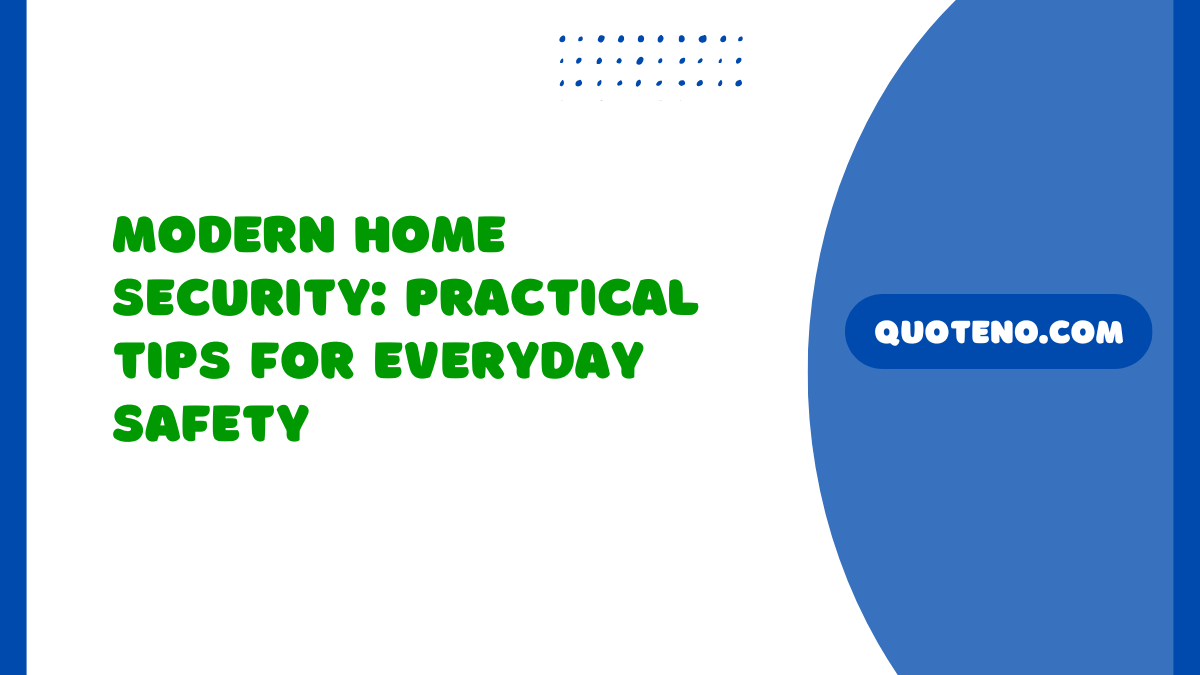Key Takeaways
- Simple upgrades can have a big impact on your home’s safety.
- New technology offers both convenience and robust protection.
- Awareness and routine checks are as important as physical security measures.
- Practical advice from trusted sources can help you make informed decisions.
Table of Contents
The Growing Need for Effective Home Security
Across neighborhoods and cities of all sizes, stories of break-ins and attempted burglaries make headlines with growing frequency. Changing demographics, technological advancements, and even wide-reaching online marketplaces can sometimes make it easier for would-be intruders to identify potential targets. According to FBI data, more than one million burglaries occur annually in the United States, resulting in losses totaling billions of dollars each year.
While these numbers might seem daunting, they also highlight the importance of being proactive, regardless of the location or age of a home. A robust approach to home security is not only about defending valuables; it’s about creating a sense of sanctuary and well-being for all who live inside.
What’s promising about today’s security landscape is how accessible protection has become. For example, replacing a traditional lock with a keypad door lock Orlando delivers an innovative way to manage entry—balancing security with convenience. With such systems, homeowners can wave goodbye to lost keys and the hassle of emergency locksmith visits, setting unique codes for family, guests, or even temporary workers.
These advanced digital locks provide an enhanced level of control and significantly greater peace of mind for homeowners. They effectively reduce the everyday stress and anxiety that individuals often experience concerning who has access to their homes and personal spaces, ensuring that only trusted individuals can enter. By utilizing such technology, people can enjoy a heightened sense of security and confidence in their home environment.
Assessing Vulnerabilities: Where Are Homes Most at Risk?
Burglars often exploit vulnerabilities in homes, often through unlocked or insufficiently secured doors or windows. Back doors and ground-floor windows are particularly vulnerable, usually shielded by fences or overgrown landscaping. A detailed walkthrough can reveal potential entry points and potential vulnerabilities. Landscaping decisions also play a significant role in defending a property.
Dense shrubbery and poorly lit corners can offer privacy but also provide hiding spots. A good balance involves trimming hedges near entryways, ensuring all paths are illuminated at night, installing motion-activated lights, and planting thorny plants beneath windows. Smart landscaping not only enhances security but also enhances the property’s appearance and value, creating a visible barrier for potential buyers.
Simple Steps for a Safer Home
- Always lock doors and windows—even for quick errands or when relaxing at home.
- Install durable deadbolt locks on all exterior doors to deter forced entry.
- Upgrade to reinforced strike plates and use lengthy screws for hinges to make doors more resistant to kicks.
- Keep the perimeter well-lit with motion-sensor or dusk-to-dawn lighting by all entrances, backyards, and side alleys.
- Resist the temptation to hide spare keys in classic spots, such as under doormats or potted plants; instead, use a secure lockbox if necessary.
- Secure sliding glass doors in Great Falls, VA with a wood or metal rod placed in the track to prevent forced opening.
- Change locks or reprogram digital systems after moving in, or when keys or codes are lost or stolen, to maintain control over access.
These actions, though simple, can greatly reduce a home’s appeal to burglars. Adopting consistent habits—like doing a nightly walkthrough to check doors and windows—ensures that these security measures are effective. Each preventive step, no matter how small, adds another layer of defense. With vigilant everyday routines, homeowners and tenants alike can make their homes less inviting to opportunists without much extra effort or expense.
Technology’s Role in Modern Home Protection
Technology is redefining how people keep their homes safe. The explosion of smart security gadgets—ranging from wireless cameras to video doorbells and AI-driven alarms—gives homeowners tools once reserved for large businesses. With app-based controls, it’s possible to grant guests access, receive instant alerts about movement, and review HD footage from anywhere in the world. This level of awareness is especially beneficial for frequent travelers or parents who want an extra set of eyes on their children after school.
The Benefits of Smart Security
- Instant mobile notifications of suspicious activity
- Remote locking, unlocking, or monitoring of doors and entryways
- Customizable settings to fit different schedules and routines
- Error-proof access sharing for contractors, dog walkers, or visitors
A comprehensive guide by Consumer Reports explains how these modern tools don’t require technical expertise. Even basic camera systems offer substantial improvements over traditional setups, allowing easy DIY installation in as little as an afternoon. The result isn’t just a safer home but also greater freedom and flexibility throughout daily life, all without breaking the bank.
How to Involve the Whole Household in Security
Good security is a shared responsibility. Every member of a household, from the youngest child to the most tech-savvy roommate, should know the key protocols for staying safe. Begin by explaining the importance of never opening doors to strangers and how to check locks and alarms. Build a routine together—whether that’s a nightly checklist or scheduled tests of the alarm system.
- Teach children safe habits and when to seek help if they feel unsafe.
- Make a group routine for locking up before everyone goes to bed or leaves for the day.
- Share entry or alarm codes only with trusted individuals, and rotate them regularly.
- Practice emergency scenarios, such as fire drills or reacting to an alarm.
Empowering everyone in the household creates a culture of awareness. Involving all housemates in security decisions reduces anxiety and ensures that no one overlooks the basics, as everyone is actively engaged in the process.
When Basic Measures Aren’t Enough: Professional Solutions
Sometimes, a property’s unique needs exceed what simple DIY measures can address. Maybe you own valuable collections, travel often, or live on a large estate with multiple structures. In these cases, consulting with a security expert is wise. Professionals provide a tailored risk assessment, recommending the best combination of alarms, surveillance, reinforced entry points, and user-friendly controls tailored to your lifestyle.
Expect a thorough consultation, during which vulnerabilities are identified and specific products and practices are recommended to address them. Obtaining two or three expert opinions can help find a system that suits your needs, budget, and plans. With the right expert input, you gain not just equipment but coaching, allowing everyone in the household to adopt stronger safety habits for the long term.
Staying Informed and Adapting Your Security Strategy
The landscape of home security never sits still. Criminal tactics and smart devices both change at a rapid pace, making ongoing education critical. Checking reputable sources—like law enforcement briefings, technology news, or home safety organizations—can keep you ahead of emerging risks and the latest best practices.
Every six months or after a major change (like a move or renovation), revisit your security setup and routines. Small adjustments—adding a light, setting a temporary code, or testing the alarm—can make a significant difference. Ultimately, home security is a blend of robust technology, simple everyday actions, and a commitment to staying informed. Building a culture of security ensures that your home remains a sanctuary, giving you peace of mind in a rapidly changing world.
FAQs:
What defines modern home security?
Modern home security uses smart systems with integrated cameras, sensors, smart locks, AI analytics, and remote monitoring. These systems offer intelligent threat detection, automate responses (like locking doors or turning on lights), and blend discreetly into home design.
How do smart security systems improve safety?
They provide real-time monitoring through live video and instant alerts, allowing homeowners to respond immediately to break-ins, fire, or carbon-monoxide threats. These systems also reduce false alarms and integrate with home automation for enhanced safety.
Can smart security save money?
Yes. Homeowners can enjoy energy savings by automating lights and thermostats, and often gain insurance discounts thanks to lowered risk. These systems offer long-term value by reducing both utility and insurance costs.
Are modern systems easy to control?
Absolutely. Smart home security offers remote access via mobile apps, allowing you to view feeds, lock doors, or trigger alarms from anywhere. Integration with voice assistants like Alexa or Google Assistant also adds convenience.
What are the latest trends in home security tech?
Top trends include:
AI-powered cameras and facial recognition to reduce false alerts
Low-profile cameras and sensors that match home décor
Biometric smart locks and integration with solar-powered setups
Garage and perimeter security, addressing less-secured entry points
- Creative Ways to Make Camping Trips Fun for Everyone - November 7, 2025
- Benefits of Designing Energy-Efficient Homes - October 30, 2025
- Assessing the Reliability of Modern Library Resources for Engineers - October 28, 2025

